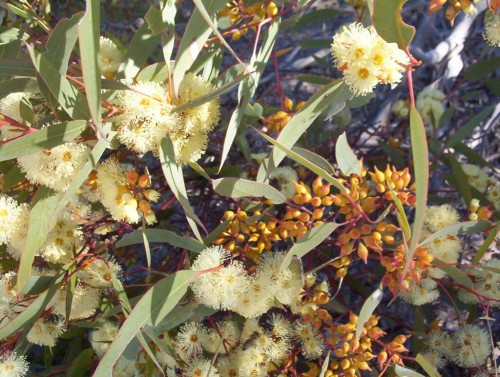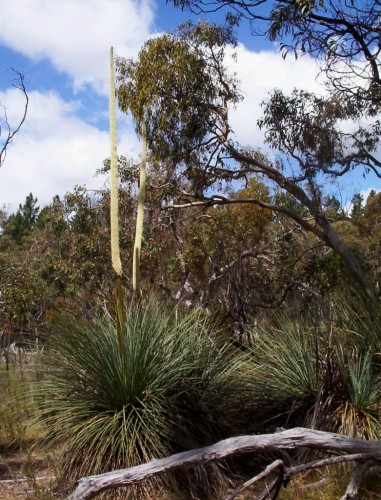Eucalyptus socialis (Red Mallee)
Most of the Eucalypts at Lowan Conservation Park are the mallee, Eucalyptus socialis. I found a good specimen to photograph. I wanted to gather an album of local Eucalypts.
The mallees are great survivors. When top branches are chopped down, or blown down, or burnt by bush fires, they shoot again from buds in the stump, called a lignotuber. The trees can look dead and be covered in new shoots within weeks.
Xanthorrhoea semiplana (Yacka, Grass Tree)
After the grasses seminar we went to Cromer Conservation Park for a picnic lunch. Husband had been bird watching there and was distracted by the great display of wildflowers. There were a number of these Xanthorrhoea plants in flower. They were growing on deep very well drained sand.
These are often sought after as feature rockery plants. The emphasis is on getting hold of tagged plants, not digging them up in the wild without a permit. Every plant that I have seen ready for transplanting has had the leaves trimmed to around 30cm or less, I assume to reduce transpiration stress.
They do not have an extensive root system. They need good drainage, so raise the planting spot if needed, and give it an open sunny aspect. Keep moist but not soggy, so test the soil in the top 4-5cm for dryness before watering again. I think a mulch of small gravel or course sand, failing that, leaf litter to retain moisture during the summer and keep soil temperature from extremes while the plant is establishing is a good idea.
Gardening With Australian Native Plants
Last week I received an email from Stuart in Western Australia at Gardening Tips ‘n’ Ideas. He asked me to be featured on his blog by answering a few questions along the lines of ‘When did I begin Gardening as a hobby, Why have a blog, What useful tip had I picked up along the way, etc. The whole article can be read here. A number of gardeners were asked to fill Stuart’s blog entries for a few days, including a some from the USA.
When I looked at what I had written it brought back a lot of memories. The country town we lived in when we were first married had a progressive Parks and Gardens Officer. He began a huge street planting scheme to the extent that this town has a great tree line which is so obvious when compared to the surrounding flat country side of salt bush. These days one would say that mistakes were made regarding species selection but at least there is this lovely greenery in a hot dry area.
I joined the Australian Plant Society in 1976. The magazines and Journals that I have kept for the past 30 years are a fantastic resource. When I consider that what was experimental then is now common place regarding propagating and growing Australian native plants, the accumulated knowledge is phenomenal.
Why do I write about Australian native plants? They are magical in their colours, shape and form. They fit into any garden type, mixed with exotics or on their own. I find them interesting and exciting plants. Many have unique needs to enable propagation. Many have unique needs to be able to grow them in the garden, especially in this country where climatic conditions are so varied. Our native birds, animals and insects need them to survive and the plants themselves need those birds, animals and insects in order to set seed and survive.
Make Cuttings To Save Plants
Our local group of the Austarlian Plant Society planted many native plants in a scrub area attached to a retirement village in 1986. This was part of the South Australian Jubilee 150 Celebrations. Many of the plants are rare or endangered. We heard today that a part of the garden will soon be bulldozed to make way for more development in the village. It is a shame this will happen. The garden is part of the amenity available to residents.
As a result of this development we are going to chop the plants in order to take as many cuttings as possible so the plants will not be wasted. The small plants we will attempt to relocate even if we have to pot them first and treat them as large ‘cuttings’.
This garden has been the source for many plants I have raised from cuttings. Many of the plants are only available at Autumn and Spring Plant Sales held by the Australian Plant Society because I have been fortunate in being able to strike cuttings from them.
Plants at Monarto Zoo
This morning we took we took my mother and niece to Monarto Zoo, about an hour east of Adelaide along the South Eastern Highway. We haven’t done the bus tour for ages. It was great although very cold today.
A highlight of the trip was seeing two brand new baby giraffe, born last Friday and Saturday. One was still wonky on its legs but got up to suckle for a while from its mother. The other was content to doze in the weak sun for a while. Giraffe are amazing creatures.
As are the African Painted Dogs. There has been a good season for them too. Heaps of 6-8 week old puppies scrambling and playing quite roughly with each other. It was quite a creche. Apparently the other adult dogs help to raise the pups and feed them. One adult was giving quite strong taps with its front paw to a pup.
There is such a lot to see at the Zoo. New developments are taking place as money becomes available. We enjoyed a concert there last year, with the Adelaide Symphony Orchestra. This was a fund raiser for the Zoo.
On one of the walks today there was an abundance of Lomandra effusa, Scented Mat Rush. In fact the vegetation was looking in good heart. This Lomandra was in quite dense communities. It will be good to do the walks at the end of the winter as this is an area where the wild flowers are lovely then. Prostanthera eurybioides (Monarto Mint Bush) was in flower in the Zoo plantings.

